Which plot represent an exothermic reaction ?




The correct Answer is:A
To determine which plot represents an exothermic reaction, we need to understand the characteristics of exothermic reactions in terms of enthalpy (ΔH). Here’s a step-by-step solution:
Step 1: Understand Exothermic Reactions
An exothermic reaction is one in which heat is released into the surroundings. This means that the enthalpy change (ΔH) for the reaction is negative. In simpler terms, the energy of the products is lower than the energy of the reactants.
Step 2: Analyze the Options
We are given four options (A, B, C, D) that represent different plots of energy versus reaction progress. We need to identify which plot shows that the products have lower energy than the reactants.
Step 3: Evaluate Each Option
- Option A: If the plot shows that the energy of the reactants is higher than that of the products, this indicates that energy has been released, thus representing an exothermic reaction (ΔH < 0).
- Option B: If the plot shows that the energy of the products is higher than that of the reactants, this indicates that energy has been absorbed, representing an endothermic reaction (ΔH > 0).
- Option C and D: If both reactants and products are at the same energy level, it indicates that there is no net change in energy (ΔH = 0), which does not represent either an exothermic or endothermic reaction.
Step 4: Conclusion
From the analysis, Option A is the only plot that represents an exothermic reaction because it shows that the products have lower energy than the reactants.
Final Answer
Option A represents an exothermic reaction.
---
An exothermic reaction is one in which heat is released into the surroundings. This means that the enthalpy change (ΔH) for the reaction is negative. In simpler terms, the energy of the products is lower than the energy of the reactants.
We are given four options (A, B, C, D) that represent different plots of energy versus reaction progress. We need to identify which plot shows that the products have lower energy than the reactants.
- Option A: If the plot shows that the energy of the reactants is higher than that of the products, this indicates that energy has been released, thus representing an exothermic reaction (ΔH < 0).
- Option B: If the plot shows that the energy of the products is higher than that of the reactants, this indicates that energy has been absorbed, representing an endothermic reaction (ΔH > 0).
- Option C and D: If both reactants and products are at the same energy level, it indicates that there is no net change in energy (ΔH = 0), which does not represent either an exothermic or endothermic reaction.
From the analysis, Option A is the only plot that represents an exothermic reaction because it shows that the products have lower energy than the reactants.
Option A represents an exothermic reaction.
Topper's Solved these Questions
- THERMODYNAMICSBOOK - RESONANCE ENGLISHCHAPTER - THERMODYNAMICSEXERCISE - Exercise -2 Part-I: Only one option correct type
23 Videos
- THERMODYNAMICSBOOK - RESONANCE ENGLISHCHAPTER - THERMODYNAMICSEXERCISE - Exercise-2 II: Single and double value integer type
16 Videos
- THERMODYNAMICSBOOK - RESONANCE ENGLISHCHAPTER - THERMODYNAMICSEXERCISE - H-1
1 Videos
- TEST SERIESBOOK - RESONANCE ENGLISHCHAPTER - TEST SERIESEXERCISE - CHEMISTRY
50 Videos
Similar Questions
Knowledge Check
Which of the following graphs represents exothermic reaction ?
 A(i) onlyB(ii) onlyC(iii) onlyD(i) and (ii)
A(i) onlyB(ii) onlyC(iii) onlyD(i) and (ii)Which of the following graphs represents exothermic reaction ?
 A(i) onlyB(ii) onlyC(iii) onlyD(i) and (ii)
A(i) onlyB(ii) onlyC(iii) onlyD(i) and (ii)Which of the following graphs represents exothermic reaction ?
 A(i) onlyB(ii) onlyC(iii) onlyD(i) and (ii)
A(i) onlyB(ii) onlyC(iii) onlyD(i) and (ii)
Which of the following graph represents exothermic reaction ?

View SolutionCarrot cycle is plotted in P-V graph . Which portion represents an isothermal expansion ?

View SolutionDecomposition of Silver chloride is an exothermic reaction. True/False
View SolutionState the effects of endothermic and exothermic reactions on the surroundings.
View SolutionThe dissolution of quicklime in water is an exothermic reaction. Why?
View Solution
